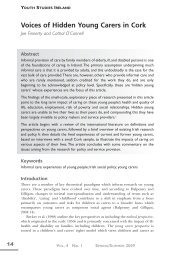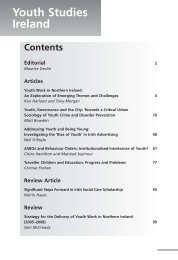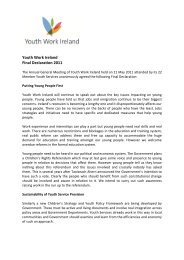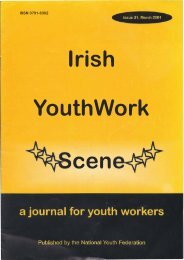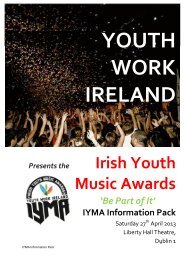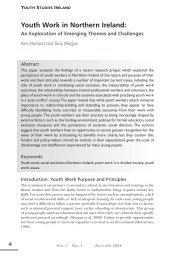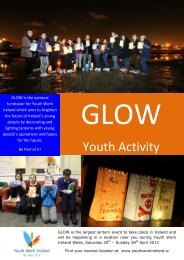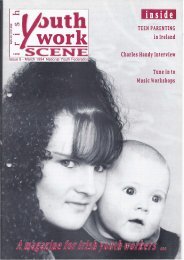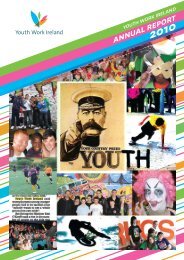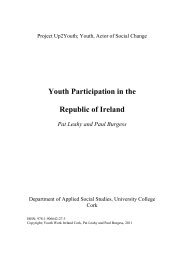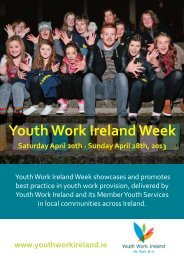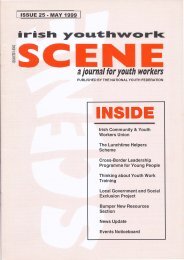Issue 34: November 2001 - Youth Work Ireland
Issue 34: November 2001 - Youth Work Ireland
Issue 34: November 2001 - Youth Work Ireland
You also want an ePaper? Increase the reach of your titles
YUMPU automatically turns print PDFs into web optimized ePapers that Google loves.
has the obligation of caring for those in need within theirlocality. At the centre and providing the Inspiration for thissort of development in <strong>Ireland</strong> over the last thirty yearshave been voluntary social services or communityco uncils. The most important disti nctive features of thesewere the fact that they were based in, related to, andesta blished by the local co mmunity. They were concreteexamples of individual communities facing the needs andproblems of their own communities and channeling theirenergies and resou rces to help themselves. This wholemovement is an attempt to return to locally based help forthe needy which was the case in the past. Generallyspeaking, ind ustrialisation and urbanisation in 19thcentury Europe led to Statutory Social Welfare provisionin the way we know it. Prior to this, relief for the poor anddestitute was an integral fu nction of local parish andcommunity life.There have been in the last century various efforts torestore and refashion the Pre-Industrial revolutionemphasis on the local community's concern for the wellbeing of all it's members. We have had for example thesettlement work of Samuel Barnett in the East End ofLondon or Sir Horace Plunkett's co-operative movementin this country. It is not unfair to say that Governmentsgenerally tend to fight shy of such developments andcannot provide realistic fu nding which was required for itto take root. A vibrant involved local community meansreduced alienation, opportunities for self fu lfillment,feelings of powerlessness overcome, improved individualand group self image, and generally increased co mmunityinteg ration and co-operation. Much has been done in thisarea loosely called community development and muchstill needs to be done in rebuilding co mmunity local ly.These various types of Councils were concrete examplesof individual co mmunities fa cing the needs and problemsof their own community and channeling their energies andresources to help themselves. This has improved thequality of life in many local communities and helped thecommunity to develop its fe eling of self worth, and reta inpower over its own co mmu nity life, Statutory services,however extensive and effective cannot provide this sortof community development. Perhaps most astonishing ofall was the facility with wh ich a number of co mmunitiesresponded and the wide range of developments onvarious levels which were initiated.Open Ended Development and Specialist ServicesAny of us who has been involved with Community orSocial Services Councils will be very conscious of how thedevelopment of a service leads inevitably to analysis,discussion, and identification of a new need and thereforeprogrammes or services to meet those needs. None of usinvolved with the Centre would have been aware of thespecialist services and the personnel and facilities whichwould have been needed here. Much has been providedand there will be an opportunity to plan fresh responses tonew needs. I don't want to preempt or anticipate thatdiscussion but let me make one suggestion.Within each community there is a stock of untappedresources. People, in responding to the need of their owncommunity, thereby improve the feeling of self worth of thecommunity, create a feeling of effective ness and a senseof contributing to their own wellbeing through localinvolvement in local based voluntary organisations. It isessential to create mu ltiple types of opportunity to helppeople to become involved in various forms of communityservice. In particular there are people prepared to play apart on an occasional basis but who are unable orunwilling to make the permanent commitment of joining anexisti ng organisation. In this context publicity andrecruitment systems and a comprehensive volunteerbureau structure could be of immense value in every area.That leads me on quite naturally to another importantissue. One of the negative phenomena of the last decadehas been the disintegration of quite a number of areasacross the county of the particular model of communityawareness and involvement. Indeed in some areas therehas been a virtual disengagement from theneighbourhood and co mmunity life by significant sectionsof the local population. We have see n, what weassociated in the past with very large cities or with foreignco untries, becoming a reality in even small towns in<strong>Ireland</strong>: Contact with only a handful of neighbours; Noknowledge of co mmunity needs, concerns, developmentand structures; An unwillingness to become involved incom munity organisations or in providing com munityservices; Availing of some community provisions only onthe basis of self-interest ('community consumers") and notinvolved at all as 'community producers'.People have tended to isolate themselves domestically,and television and other forms of home entertainment andthe increased pace of modem and work life haveaccelerated this process. Recent su rveys in Britain forexample show that nearly a third of the population hasnever spent one evening with a neighbour. Professor. John Locke of the University of Sheffield, writing in TheGuardian on March 11 th 2000 had this to say in a 1997study of over 1000 British office workers: nearly half saidthe Internet had replaced face to face co mmunication;over a thi.rd said they used email deliberately to avoiddirect interactions. Verba lly abusive 'flame mail' wascommonplace, often leading to a complete breakdown ofrelations. This is not the great global society we werepromised.The problem lies in the nature of human communication.We think of it as a product of the mind, but it's done bybodies; faces move, voices intone, bodies sway, handsgesture. Evolution provided each of us with specialisedIrish <strong>Youth</strong><strong>Work</strong> Scene<strong>November</strong> <strong>2001</strong>



